Shade-loving flowers
This group of ground cover plants feels comfortable even in full shade. They can be safely planted on the northern side of the site or decorated with trunk circles. Even in the absence of sunlight, they will bloom profusely and retain a bright color.
Periwinkle
Rapidly growing ornamental culture no more than 0.2 m in height. Leaves are glossy, ovate, with a pointed tip. During flowering, it is densely covered with flowers of different colors (snow-white, pale blue or pale pink). Sometimes there are variegated options.
 Periwinkle is a rapidly growing ornamental culture
Periwinkle is a rapidly growing ornamental culture
Heuchera
The plant came to us from North America and Mexico. The length of the shoots is about 50 cm. It grows in compact bushes, covered with folded leaves with uneven edges. Their shade ranges from yellow-lime to maroon. Heuchera blooms with panicles of light pink color.
Tenacious creeping
This perennial is found almost throughout Europe. Stems 20-35 cm long form a lush bush with purple-blue candle inflorescences. The leaf plates are dark green, oval-elongated, slightly wavy. In some species, a purple hue or pale yellow speck predominates on greenery.
Zelenchuk
The natural habitat of this soil-cultivator is deciduous forests of the temperate zone. Creeping shoots grow up to one and a half meters in length, densely leafy. Leaves are spotty, lanceolate or heart-shaped, serrated, covered with fine hair. Inflorescences are small, lemon-yellow in color.
Saxifrage
An ornamental perennial that grows in alpine meadows. Its height rarely exceeds 15-20 cm. Creeping shoots, oval leaf plates form rosettes. Flowers of a simple structure, with five petals of a snow-white or crimson-pink hue. In the shade or partial shade, the color becomes less bright.
 Saxifrage is a perennial growing in alpine meadows
Saxifrage is a perennial growing in alpine meadows
Clefthoof
A slow growing groundcover from Southeast Asia that loves shady areas and moist soil. Differs in large rounded leaves of a dark emerald hue. The surface is smooth, glossy. Small burgundy-red flowers that hide under the greenery are almost imperceptible.
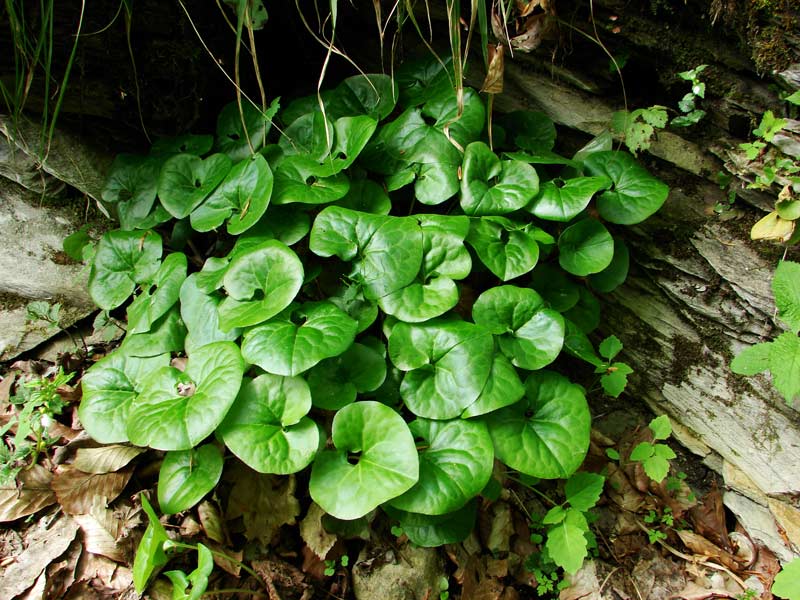 Clefthoof - Slow Growing Ground Cover
Clefthoof - Slow Growing Ground Cover
Ivy
The plant is native to Australia and the Northern Hemisphere. A creeping shrub that can grow vertically or spread over the ground. The length of its stems sometimes reaches several meters. The leaf plates are wide, with angular edges, covered with fine pile. Ivy is often used to decorate hedges, walls, or fences.
Woolly chisel
Perennial is found throughout Eurasia. Its height is about 0.3 m. A characteristic feature of the chisel is terry silvery-gray leaves covered with pile. They are lanceolate, with sharp edges and a slightly pointed tip. The ground cover blooms with spikelets of a lilac-pink hue.
Lamb
The homeland of this plant is Europe, North Africa, Asia. Long creeping shoots and leaves in the shape of a heart with a marble pattern are characteristic of the lamb. Perennial blooms with small purple inflorescences. He does not like over-dried soil, but he quickly recovers after the resumption of moisture.
Care
Perennial plants are renewed approximately every five years to avoid weed growth. They do not require special fertilizers, otherwise the plant weakens and stops blooming. Top dressing is applied once at the beginning of the season.
Watering is carried out only during the swelling of the buds.

Watering such flowers is necessary only when the buds swell.
When choosing a site, pay attention to the high growth rate - in a couple of years, three geranium bushes can occupy an area of 1 square meter. Experienced gardeners do not plant different types of perennial plants next to each other, as they can begin to crowd out each other.
For planting, you can use daffodils or daylilies, as well as annual plants.
Experienced gardeners do not plant different types of perennial plants next to each other, as they can begin to crowd out each other. For planting, you can use daffodils or daylilies, as well as annual plants.
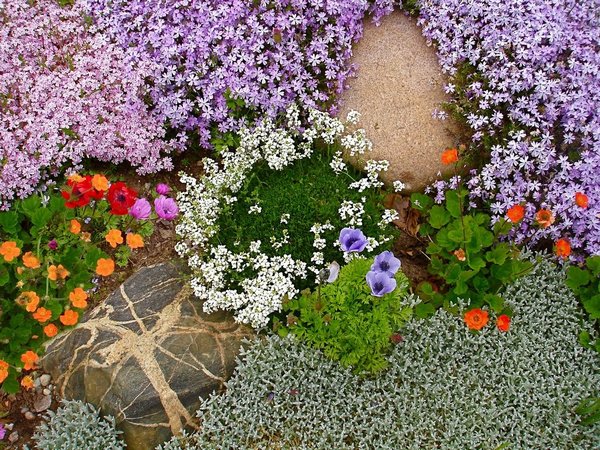
It is better not to plant several ground covers next to each other.
Growing ground cover perennials is within the power of even a novice florist, they grow quickly, without requiring significant maintenance.
Learn more about the variety of perennial ground cover plants
Ground covers can be defined as plants whose height does not exceed 20 centimeters, which have such a feature as rapid growth. There are specimens that reach a height of a little less than half a meter: for example, badan or geychera.

Heuchera
Some groundcover grows with shoots that quickly fill up the space. These include obrietta, an awl-shaped phlox.

Subulate phlox
Try planting bulbous flowers such as daffodils and ferns in a shaded flowerbed with a carpet of light green, creeping plants like sedum or moss, and you will be amazed at how a previously inconspicuous corner of the garden can be transformed.
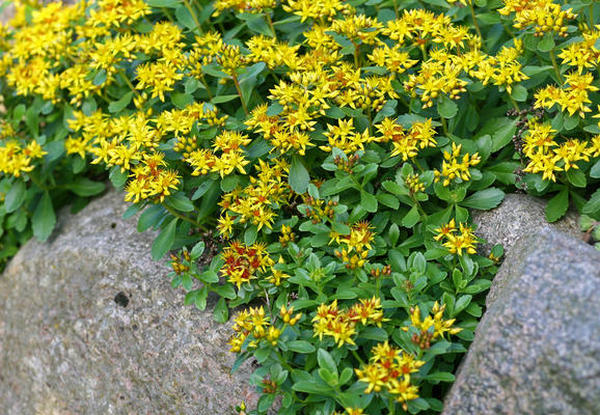
Sedum
Yaskolka and periwinkle are evergreen ground cover, they retain their leaves even in the cold season.
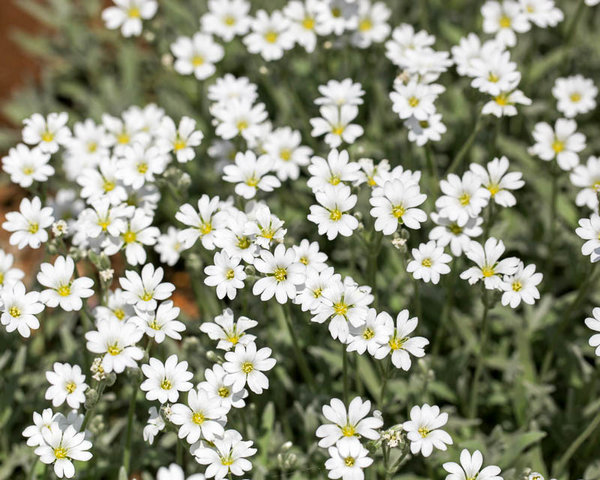
Yaskolka
The obvious advantages of such plants:
- long life and the ability to grow in one place without transplanting;
- a high degree of resistance to external adverse factors;
- no requirements for high soil fertility, unpretentious to watering;
- tolerate drought and frost well;
- mulch the earth, not letting it dry out, retain moisture;
- perform decorative functions for a long time.

Such plants mulch the earth
A variety of varieties and types allows you to choose the ideal option for any conditions.
More about perennials
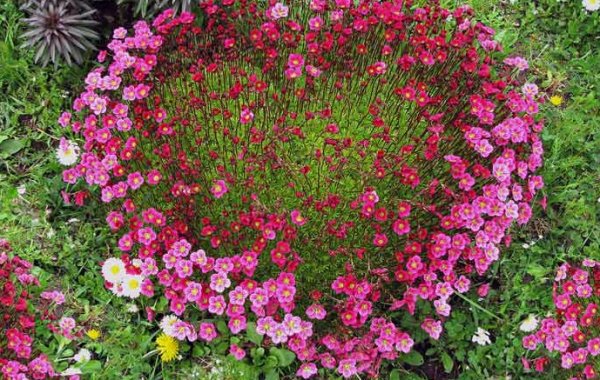
Such plants are used to decorate flower beds.
In addition to the attractive appearance, the following positive aspects of growing these flowers can be distinguished.
- Ground cover plants prevent the top, most fertile soil layer from being blown away and washed away by rain.
- Such plants are able to resist the growth of weeds, since the latter are simply displaced from the site.
- With the help of ground cover perennials, you can decorate not the most attractive corners of the garden in a short time - these plants grow very quickly.
- They participate in the saturation of the soil with oxygen, which has a beneficial effect on fertility.
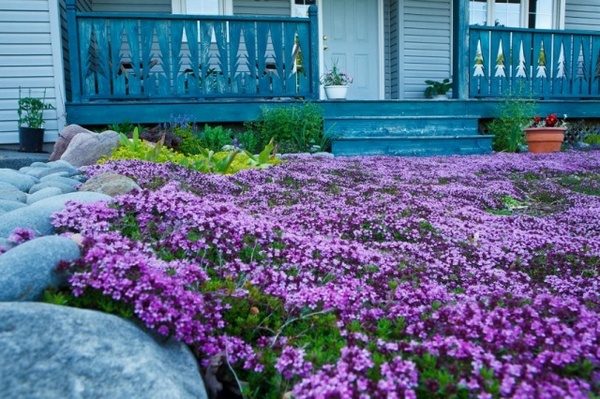
Ground cover perennials saturate the soil with oxygen
In addition to the above, you can also highlight the advantages of these flowers over other ornamental garden plants.
They are unpretentious to care for, so they can grow well in areas with soil that is poorly saturated with nutrients. The less fertilized the soil, the thicker and more abundant flowering occurs, since the plant begins to spend energy on the growth of leaves, rather than flowers.
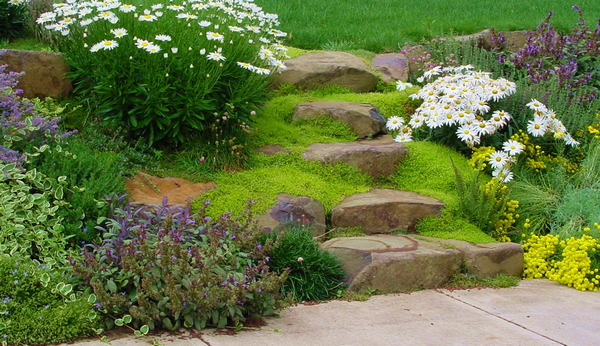
Such plants are unpretentious to care for.
These flowers can be grown in both lighted areas and shaded areas, so species can be easily matched to the location of the garden.
Inflorescences and stems dying off in the cold season are a good natural fertilizer.
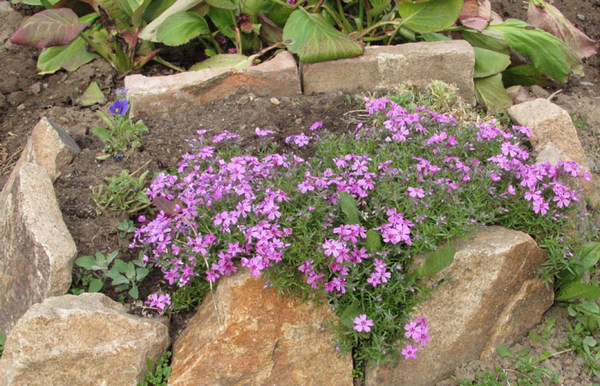
Dying inflorescences are a great fertilizer for other flowers
Ground cover plants mulch the soil because the dense plant cover prevents the soil from drying out in the bright sun and prevents the growth of weeds.
Plants are perennial, therefore, it is enough to take care of planting them only once, and then propagate them by means of vegetative methods, such as cuttings and dividing bushes.

This plant is perennial
The choice of plants of this species is very rich - many varieties will allow you to choose exactly the kind of flowers that you like. There are ground covers with beautiful leaf shape or especially rich flowering. Plants have different growth rates and flowering seasons.
When planting varieties that bloom throughout the summer season, you do not need to worry about careful care - they are resistant to drought and poor soil, they tolerate shade well, and in some cases frost (for example, spotted lamb and styloid phlox).
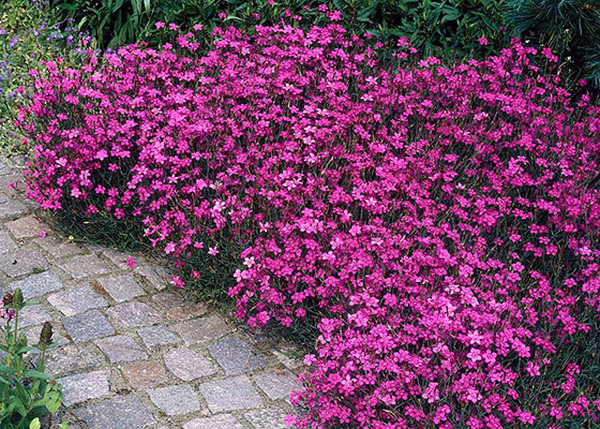
Such plants are drought tolerant
Evergreen Species for Living Carpets
Many evergreen species belong to ground cover:
Aubrieta blooms throughout the warm season, starting in late spring.
- Felt cradle. It can grow on any type of soil, even depleted, with the arrangement of high-quality drainage. During one season, it forms a low and dense cap of silvery-gray leaves. From late spring until the onset of cold weather, it is densely covered with small white star-shaped flowers. After massive flowering, it needs pruning. Dividing the rhizome every 2-3 years will preserve the best qualities of the plant, which is actively used to decorate borders, rock gardens, decorative walls or planting in pots and flowerpots.
- Aubrieta. Prefers well-drained sandy or rocky, lime-rich soils. Flowering begins in late spring and continues throughout the warm season. Pink, purple, purple or red flowers are set off by dense gray-green foliage. Due to this, the herbaceous shrub looks most decorative in rock compositions, rock gardens and ridges. The species includes plants with non-double, semi-double and double flowers of various sizes.
- Periwinkle. The most undemanding perennial groundcover with evergreen foliage. It is equally successfully grown in various climatic zones, regardless of the type of soil. It grows very quickly and aggressively, which is often used on erosive soils. Blooming with numerous lilac flowers begins in the second half of May. In warm autumn, periwinkle can bloom again.
- Creeping tenacious. Differs in good drought-resistant qualities. Depending on the variety, it can have monophonic or multi-colored foliage with high decorative effect. Requires ample space for growth, as it quickly loses its attractive appearance in confined areas. Most often used to create spectacular carpets when decorating flower beds or lawns. Prone to damage by late blight and fungal root rot.
- Sedum (sedum). It takes root well in regions with different climatic conditions. Virtually no need for care and maintenance in both humid and arid areas. It grows and blooms profusely under the scorching sun without requiring shading. Produces sweet nectar that attracts bumblebees, bees and butterflies. Cut flowers can be used as dried flowers.
- Arabis, or alpine rezuha. Prefers rocky and stony soils, due to which he feels most comfortable when decorating alpine slides, rock compositions or stone walls. It blooms with small white flowers, collected in an ear.
Stonecrop pests and diseases
It is practically not affected by pests, but, very rarely, it is attacked by slugs, root and root nematodes, and aphids.
Stonecrop diseases: wilting, leaf spot, rust.
Sedums (sedums) perfectly cover the nondescript lower parts of the stems of perennial asters or phloxes, and also look very impressive as an independent group, especially near a reservoir.They are planted along the edge of garden paths, in groups to create flower carpet compositions, indispensable in border and mixborder plantings, rocky gardens. Good combination with chrysanthemum, heuchera, echinacea, saxifrage, cereals, hosta.
Decoration for any interior - Morgan sedum
Sedum or in another way Sedums are succulents from the Tolstyankov family.
In our country, sedums are often called "squeaky", "febrile grass" or "hernial grass".
There are over 500 species around the world. But among those that grow at home, the most famous is Morgan's sedum.
The stems of this representative are not thick, but rather long, they can grow up to one meter, very densely covered with leaves. Most often, all stems grow from the very root, branching is extremely rare.
The leaves of the squeak are very original - fleshy, thick at the base, and pointed at the top, resembling fangs or claws in shape.
Leaves adjoin along the entire stem, as they do not have petioles.
The color can be either green or gray-green, or slightly bluish. Smooth to the touch with a slight waxy coating, which is a shield against sunburn.
Because of its appearance, Morgan's sedum is also often called "hare cabbage".
The flowers of the hernial grass are located at the very tip of the hanging stem on very long pedicels, collected in inflorescences of up to 10 pieces each.
The color is bright pink or red, sometimes purple. The buds are tulip-shaped, when opened - a five-pointed star with bright yellow stamens inside.
Morgan's sedum:
Sedum Morgana:
Sedum Morgan is a capricious and demanding plant, but with proper care at home, its effectively descending stems will become a real decoration of any interior.
When buying, choose a small plant without external damage, the leaves-cloves should be smooth without wrinkles. Purchase the container immediately.
It is advisable not to take a large pot. The root system of the squeaks is small, so 10 - 12 cm in diameter, shallow, is suitable.
Planting or further transplants is best done in the spring, once every 2 - 3 years is enough, due to the slow growth.
Mix for planting as follows: mix in equal proportions turf and deciduous soil, sand and high peat, a little crushed charcoal.
You can buy ready-made soil for cacti. A drainage layer must be poured at the bottom of the pot, use expanded clay or broken brick.
Top dressing is carried out with conventional fertilizers for succulents and cacti once a month, preferably with a low nitrogen content, except in winter.
Lighting and thermal conditions
Since sedum came to us from hot countries, then it grows best in a sunny place, a window facing south or southeast will do.
Not afraid of direct sunlight. It perfectly tolerates temperatures from +23 to +30 degrees. In summer, you can take it out into the fresh air.
Air humidity
Hare cabbage grows well with moderate air humidity, but it also tolerates drier air well, so it is often not necessary to spray the plant.
Just to freshen up and dust off.
Feverish grass is a succulent, which means that it tends to accumulate moisture inside, it is necessary to water such a plant with caution. A slight drought is not terrible, and a large amount of water will cause rotting of the root system.
A slight drought is not terrible, and a large amount of water will cause rotting of the root system.
From watering to watering, make sure the clod is 1.5 cm deep and dry well.
If Morgan Sedum fills the pot completely, just test how the pie is with a toothpick so you don't touch the plant.
It is better to use water at room temperature.
This type of succulent is more classified as decorative deciduous.
It can only occur in fairly old plants and only in very hot summers, with proper care and maintenance during the dormant period.
Preparing for winter
An important period in the life of a plant is the dormant period. To begin with, reduce watering in the fall.
The earth ball should dry out at least 3 cm deep, once every two weeks. We have not applied fertilizers since November.
Then we rearrange the sedum into a cool room at a temperature of +8 to +13 degrees, but the lighting must be sufficient, otherwise the shoots will stretch out.
You can make an electric backlight. This period of rest for stonecrop lasts from November to March.
Caring for the tenacious in the garden
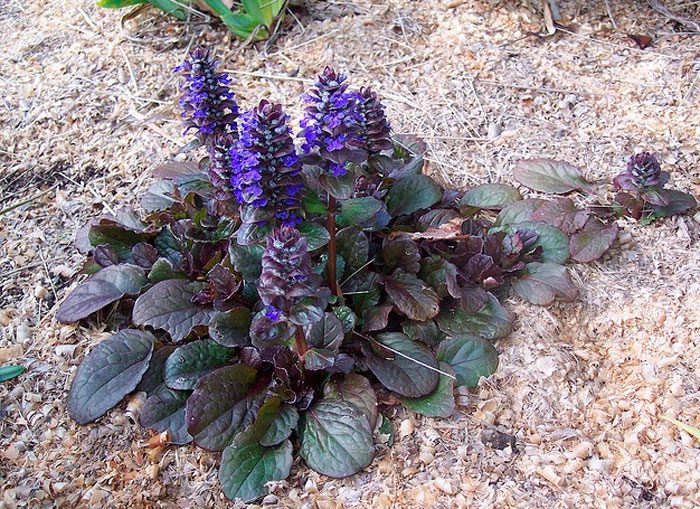
It is relatively easy to care for Ayuga. The bushes need to be watered systematically, as well as to prevent their uncontrolled spread. Before young leaf plates appear on the planted plants, they need to be protected from direct rays of the sun, and the tenacious needs timely watering, make sure that the soil near the bushes never dries out. After the rosettes start to grow, the plants are practically not watered, this should be done only during extreme heat or a long dry period. Remember that such grass can grow extremely quickly, so it is necessary to constantly monitor so that it does not spread into areas not intended for it. A fence can be made around the perimeter of the site, for this you need to surround the plant with stones, and only slightly press them into the soil. To preserve the spectacular appearance of the decorative leafy species of Ayuga, it is recommended to cut off the inflorescences in a timely manner.
Reproduction of the tenacious

Such a herbaceous plant can be propagated by seed and vegetative methods. But it should be borne in mind that it is recommended to grow ayuga from seeds only during the initial planting. If you cultivate varietal plants, then remember that the seeds collected from them are not able to retain the characteristics of the mother plant. In this regard, they are propagated by rosettes. Vegetative reproduction of the tenacious is carried out in early spring or in autumn (until the second decade of September). Overgrown sockets should be cut off from the bushes, which are transplanted to a new place one by one or several pieces. It happens that the outlet has only 1 thin spine, despite this, it can quite successfully take root in a new place. In the event that the outlet is separated once a year, then when planting between the bushes, a distance of 15 centimeters should be observed. If this procedure is carried out once every 2 years, then at least 0.25 m should be left between the plants. After the sockets take root and start growing, they stop watering.
Ayuga can reproduce itself by self-sowing, but at the same time the grown young plants will not be able to preserve the varietal characteristics of the mother bush. To prevent self-seeding, peduncles should be cut off in a timely manner. So, in deciduous species, this should be done when the arrow just begins to grow, and in flowering species, when they have faded. This lesson is quite laborious, but the basic care of the tenacious is very simple.
Garden design. Planting and breeding of a tenacious
Diseases and pests
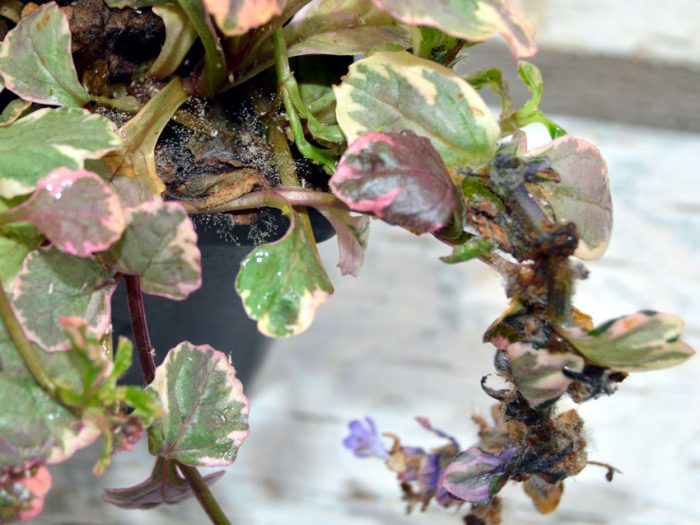
Ayuga is highly resistant to diseases and pests. However, such a plant can be disturbed by slugs, which eat its delicate leaves at night. As a rule, slugs are activated at high humidity and low air temperatures. However, for such gastropods, a strip of crushed stone or gravel will become an almost insurmountable obstacle, such a "fence" is made around the site with the tenacious.
Ground covers in landscape design
The advantage of creepers is their versatility. Using ornamental shrubs, you can carry out different planting options:
- fill the voids in the area;
- frame curbs or paths;
- arrange flower beds;
- decorate alpine slides;
- use to create rockeries;
- to make "carpet" lawns.
 Creeping plants are actively used in landscape design.
Creeping plants are actively used in landscape design.
To make the garden look neat, we advise you to follow several rules of landscape design:
- place in the neighborhood different varieties that differ in color and shape;
- it is better to frame flowerbeds or borders with “rugs” of the same type;
- for rockeries, alpine slides or other stone compositions, succulents are more suitable.
When planting flowering ground covers, make sure that the colors are compatible.
Author's advice
With their species diversity, unpretentious ground covers can give odds to any ornamental plant. In addition, they do not require additional maintenance and at the same time maintain the aesthetics of the garden for a very long time.
Shade-loving
A good solution for shaded areas of the garden will be "carpet" coverings of shade-loving creeping plants.
Saxifrage
A plant 15–20 cm high forms a dense “carpet” with small white or dark pink flowers. Thin creeping stems are covered with small, fleecy, rounded leaves. The soil for a perennial should contain fine gravel or coarse sand, since moisture should not stagnate during watering. Experienced gardeners recommend adding crushed limestone to the soil before planting.
Periwinkle
A short (10–15 cm) evergreen perennial is distinguished by its rapid growth. During the flowering period, the creeping shrub is covered with small blue, white or pink flowers. Oval-shaped leaf plates, monochromatic or variegated. Periwinkle feels best on loam.
 Periwinkle - evergreen perennial
Periwinkle - evergreen perennial
Heuchera
Perennial herb 50 cm tall is named after the German botanist Johann Heicher. Leaves are basal, angular-lobed, rich green or burgundy. Small flowers form white, pink, red paniculate inflorescences. The groundcover loves light soil with good water drainage.
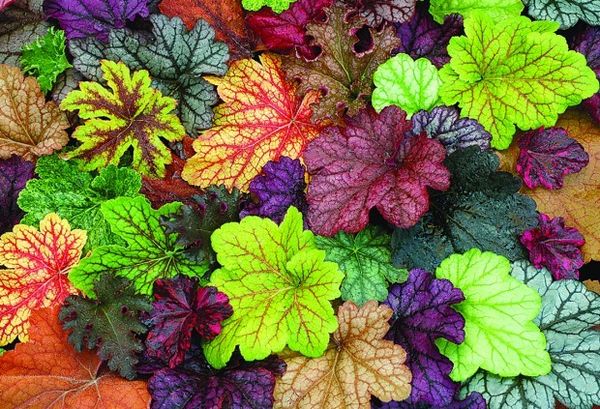 Perennial herb Heuchera
Perennial herb Heuchera
Ivy
Evergreen vine, the stems of which are covered with dense leathery leaf plates. On non-flowering shoots, they have an angular-lobed shape and are much darker than the oblong leaves on flowering branches. The ground cover plant prefers moist soil, does not differ in winter hardiness.
 Ivy is an evergreen vine
Ivy is an evergreen vine
Woolly chisel
The tall chisel (30–100 cm) got its name from the elongated, serrated foliage covered with villi. The tiny flowers form lilac-lilac inflorescences-spikelets. For greater decorativeness, they are cut at the beginning of flowering to form a thick silvery “carpet”. It is better to grow it on light soil, providing moderate watering.
 Tall woolly head
Tall woolly head
Clefthoof
Slow growing perennial with glossy, rounded hoof-shaped leaves. It blooms with small burgundy flowers, which are practically invisible behind the foliage. The plant does not like frequent watering and grows best in slightly acidic or acidic soils.
 Slowly growing perennial clefthoof
Slowly growing perennial clefthoof
Varieties and types
There are two varieties of stonecrop: "Matrona" and "Linda Windsor". The first has a high stem - up to 60 cm, and blue-green leaves with a reddish bloom. During the flowering period, sedum is covered with light pink flowers, which outwardly resemble St. John's wort. The second fell in love with gardeners for the dark red color of stems and leaves. The flowers of this plant are ruby-colored. This is a very unusual decoration for both a rock garden and a more familiar flower garden. These perennials are unpretentious to care for, they can withstand winter cold and summer drought equally well.

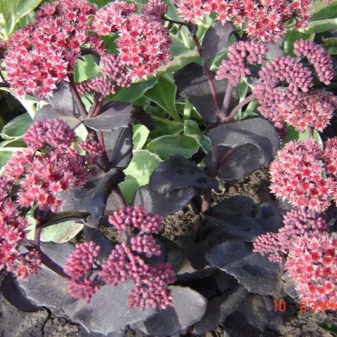
This short plant reaches only 10-20 cm in height. Its leaves are green, but by autumn they acquire a beautiful red color. Small flowers are colored white or pink. Throughout the summer cottage season, this plant demonstrates an amazing change in color, which makes it indispensable for the embodiment of any design idea. Atropurpureum and Coral Carpet leaves turn red with the onset of autumn days.
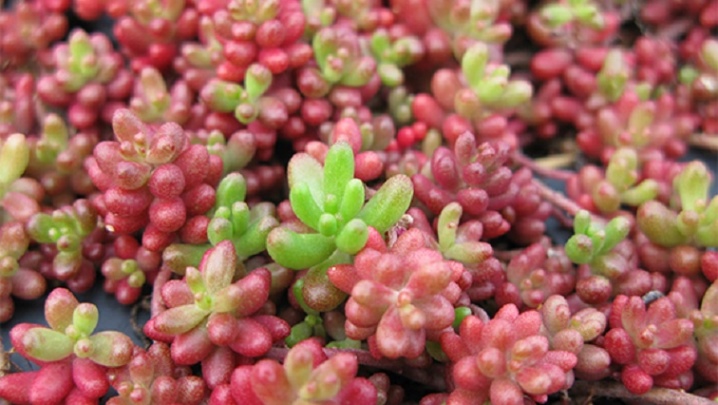
Murale leaves also change color from bright green to reddish bronze. Each variety grows rapidly.The result is a dense carpet of leaves, and June or July flowers add lightness to any composition.
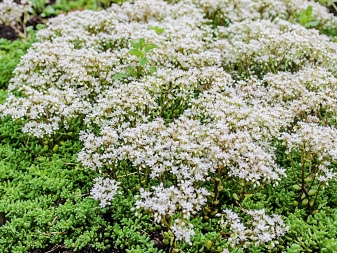
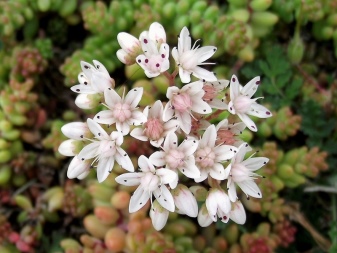
False sedum is distinguished by creeping or slightly raised shoots, the height of which does not exceed 20 cm. Thick leaves can be concave, in the form of a heart or in the form of wedges. Flowers of different varieties have their own color. Purpureum is purple, Fuldaglut and Schorbuser Blut are deep pink, Purpurteppich is deep red, Roseum is pale pink.
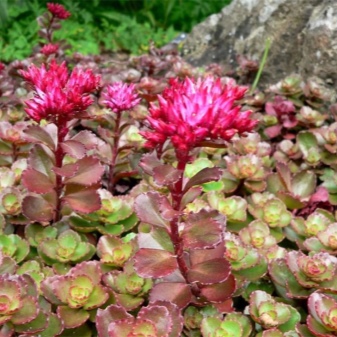

False sedum gets along well with any plants, but its color features make you choose your neighbors more carefully so that the composition looks organic. All varieties bloom in July or with the onset of August days, and each of them is characterized by luscious green leaves with purple or violet-red border around the edges.
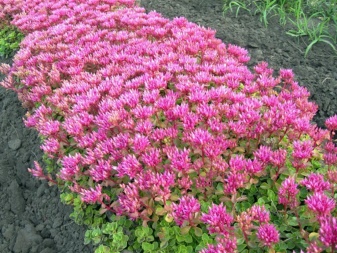
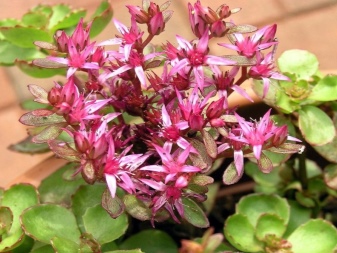
Sedum spatula got its name from its oily, scapular-shaped leaves. Small yellow flowers of this species delight with their appearance during the first two summer months. This type of sedum grows well, but grows slowly. It is also divided into several types. Cape Blanco is gray-white in color. Purpureum is distinguished by blue leaves with purple edging and a silvery bloom. They look interesting in combination with the bright flowers of the plants planted in the neighborhood. Both varieties do not tolerate cold and snowless winters. Therefore, in severe cold they should be wrapped in straw or hay.


An interesting variety of stonecrop is caustic sedum. Its height is no more than 5-10 centimeters. But the yellow leaves of its varieties allow you to place interesting accents or create a play of contrasts. Moreover, the Aureum variety is distinguished by small bright yellow leaves, and Yellow Queen is distinguished by lemon-light green leaves. Lydian sedum has similar properties. Only the color of its leaves pleases the eye with pleasant greenery, which changes its color depending on the season.

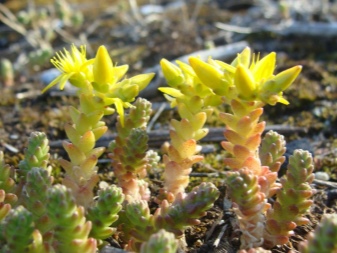
Heat-loving sedum for growing in containers
Many "southern" sedums are very beautiful and showy. Unfortunately, in the middle lane, it is almost impossible to grow them outdoors. But, fortunately, no one forbids the use of containers for this.
| Sedum Lineare | |
|
Forms a bush with raised shoots up to 30 cm long. Leaves with a bluish-white bloom, green, mint, variegated, depending on the variety. The flowers are yellow. It blooms rarely. In the middle lane, it can be grown in containers and hanging pots as an ampelous plant. |
|
| Popular varieties: Variegatum, Silverstone |
| Sedum makinoi, Sedum obovatum | |
|
Forms a dense rug with a height of 2.5-5 cm. It blooms almost imperceptibly. The leaves are green. In the southern regions it is used as a ground cover plant. In the middle lane, it is grown only in containers. |
|
| Popular varieties: Kosmosje, Limelight, Tundra Tornado |
| Sedum polytrichoides | |
|
Forms rugs up to 10 cm high. Leaves and stems are usually reddish brown. The flowers are yellow. Blooms in August-September. Does not tolerate frost and excessive watering. In the middle lane can be grown in containers. |
|
| Popular varieties: Chocolate Ball (Chocolate Ball) |
| Sedum oregon (Sedum oreganum) | |
|
Forms dense rugs 10-15 cm high. The leaves are green, turning cherry in the sun. The flowers are yellow-orange. Blooms in July-August. Loves good lighting. Does not tolerate excessive watering. In the middle lane it freezes in winter, so it is best to grow it in containers. |
|
Sedum sedum (Sedum glaucophyllum) |
|
|
Forms curtains up to 10 cm high. The leaves are bluish-green. The flowers are white. Blooms in June. Shoots take root easily. Loves loose, well-drained soil, sun or partial shade. In the south, it is used as a ground cover plant. In the middle lane, it is grown in containers, although the Silver Frost bushes can withstand temperatures down to -34 ° C. |
| Sedum pretty (Sedum pulchellum) | |
|
Forms bushes up to 15 cm high. It grows as an annual or a juvenile. Leaves are bright green, turn pink during drought.The flowers are white, pink, purple or lilac. Blooms in August-September. Prefers partial shade, good hydration. In the middle lane, it is grown in containers. |
What sedum do you like? Do not forget to show off photos of your stonecrops on our forum!


